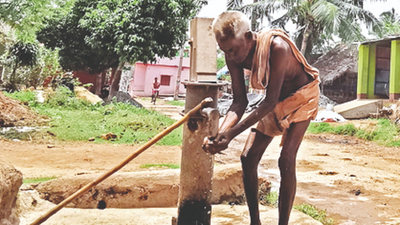- News
- City News
- bhubaneswar News
- 17 districts facing salinity in groundwater, says report
Trending Topics
17 districts facing salinity in groundwater, says report

Parts of the state are yet to achieve the drinking water target of 40 litres per capita per day, it said
BHUBANESWAR: At least 17 districts of the state are facing problems of salinity in groundwater and in many districts groundwater is contaminated with higher concentrations of fluoride, iron, nitrate, chromium (hexavalent), according to a study conducted by SwitchOn Foundation, a not-for-profit organisation working on climate change and environment. The report, which will be submitted to the state government, recommended a series of policy initiatives for groundwater recharge and better water management.
Parts of the state are yet to achieve the recommended daily drinking water target of 40 litres per capita per day (LPCD), said the report. Use of water for domestic purposes, comprising around 54% of unaccounted water losses, were observed within the system due to a lack of adequate infrastructure and metering, it said.
The study also assessed availability of water by 2051 and found that surface water availability from own drainage boundary remains more or less fixed but the inflow from neighbouring states will reduced from 37.556 BCM (billion cubic metres) to 25.272 BCM.
An assessment done by researchers of water resources indicated that by 2051, the total water requirement may go up to 85 BCM from the present 55 BCM, and the state may face severe water scarcity.
Vinay Jaju, managing director of the foundation, said, “It’s very alarming the way groundwater is getting depleted. We have technology solutions and with awareness and change in habits, we have to work on conserving water on a war footing mode. We need to take immediate action to conserve our most precious resource.”
The report recommends implementing policies to regulate the use of ground water extraction, adopting technology and practices for water conservation and water use efficiency, promotion of water-resistant crops like millets and other indigenous rice varieties, and shifting from high-water consumption crops.
Parts of the state are yet to achieve the recommended daily drinking water target of 40 litres per capita per day (LPCD), said the report. Use of water for domestic purposes, comprising around 54% of unaccounted water losses, were observed within the system due to a lack of adequate infrastructure and metering, it said.
The study also assessed availability of water by 2051 and found that surface water availability from own drainage boundary remains more or less fixed but the inflow from neighbouring states will reduced from 37.556 BCM (billion cubic metres) to 25.272 BCM.
An assessment done by researchers of water resources indicated that by 2051, the total water requirement may go up to 85 BCM from the present 55 BCM, and the state may face severe water scarcity.
Vinay Jaju, managing director of the foundation, said, “It’s very alarming the way groundwater is getting depleted. We have technology solutions and with awareness and change in habits, we have to work on conserving water on a war footing mode. We need to take immediate action to conserve our most precious resource.”
The report recommends implementing policies to regulate the use of ground water extraction, adopting technology and practices for water conservation and water use efficiency, promotion of water-resistant crops like millets and other indigenous rice varieties, and shifting from high-water consumption crops.

About the Author
Minati SinghaMinati Singha is a correspondent at The Times of India, and covers education, health, art, culture and lifestyle trends. She is fun-loving and adventurous, with a ‘never say no’ attitude. Her hobbies include reading novels, listening to music and watching movies.
Start a Conversation
FOLLOW US ON SOCIAL MEDIA
FacebookTwitterInstagramKOO APPYOUTUBE









